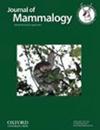金喙地松鼠冬眠前体重的成因和后果
IF 1.6
3区 生物学
Q2 ZOOLOGY
引用次数: 0
摘要
通过冬眠来应对恶劣环境条件的哺乳动物的体重会出现季节性变化,因为脂肪储备在夏季积累,在冬季耗尽。在冬眠的物种中,冬眠前的体重通常被认为是影响未来生存和繁殖成功的关键表型特征,但我们对环境条件和季节性的变化如何影响冬眠前的体重知之甚少。我们利用高海拔地区金芒刺地松鼠(Callospermophilus lateralis)种群 30 年的人口统计学数据,确定了影响雌鼠冬眠前体重的生活史和环境变量。此外,我们还确定了冬眠前体重是否会影响越冬存活率或后续繁殖。生长曲线显示了雌性体型的二态性;成年体型要到2岁才能达到,因此我们考虑了3个年龄段的雌性:幼体、1岁体和成年体(≥2岁)。我们发现,春季积雪融化的时间越早,一岁幼体和成体的冬眠前体重就越大,而且较早从出生地洞穴中出来的幼体的冬眠前体重要高于较晚出来的幼体。对食物数量或质量的估计不影响任何年龄组的冬眠前体重,也不影响繁殖状况。冬眠前体重较大的幼年雌性更有可能越冬存活并繁殖为一岁幼体,但我们没有发现一岁幼体或成年雌性会受到这种影响。我们没有发现雪深或冬季持续时间对存活或繁殖的影响。我们的研究结果表明,时间似乎是金芒刺地松鼠获得足够体质量以存活和繁殖的关键变量,但不同年龄段的金芒刺地松鼠受到的影响也不同。本文章由计算机程序翻译,如有差异,请以英文原文为准。
Causes and consequences of pre-hibernation body mass in golden-mantled ground squirrels (Callospermophilus lateralis)
Mammals that cope with harsh environmental conditions by hibernating show seasonal variation in body mass, as fat reserves are accumulated during summer and depleted during winter. In hibernating species, pre-hibernation mass is often considered a key phenotypic trait that can influence future survival and reproductive success—yet we know little about how variation in environmental conditions and seasonality affect pre-hibernation mass. We used 30 years of demographic data from a high-elevation population of golden-mantled ground squirrels (Callospermophilus lateralis) to identify life history and environmental variables that influenced pre-hibernation mass in females. Additionally, we determined if pre-hibernation mass influenced overwinter survival or subsequent reproduction. Growth curves revealed female-biased size dimorphism in body mass; adult mass was not attained until age 2 years, so we considered 3 age classes of females: juveniles, yearlings, and adults (≥2 years). We found that earlier snow melt during spring is associated with higher subsequent pre-hibernation body mass for yearlings and adults, and that juveniles emerging earlier from their natal burrows had higher pre-hibernation masses than later-emerging juveniles. Estimates of food quantity or quality did not affect pre-hibernation mass for any age class, nor was there an effect of reproductive status. Juvenile females with greater pre-hibernation mass were more likely to survive overwinter and reproduce as yearlings, but we found no such effect for yearlings or adult females. We did not find an effect of snow depth or winter duration on either survival or reproduction. Our results indicate that time appears to be the key variable for golden-mantled ground squirrels to acquire sufficient body mass to survive and reproduce, but the effects vary by age class.
求助全文
通过发布文献求助,成功后即可免费获取论文全文。
去求助
来源期刊

Journal of Mammalogy
生物-动物学
CiteScore
3.30
自引率
5.90%
发文量
106
审稿时长
4-8 weeks
期刊介绍:
Papers are published on mammalian behavior, conservation, ecology, genetics, morphology, physiology, and taxonomy.
 求助内容:
求助内容: 应助结果提醒方式:
应助结果提醒方式:


